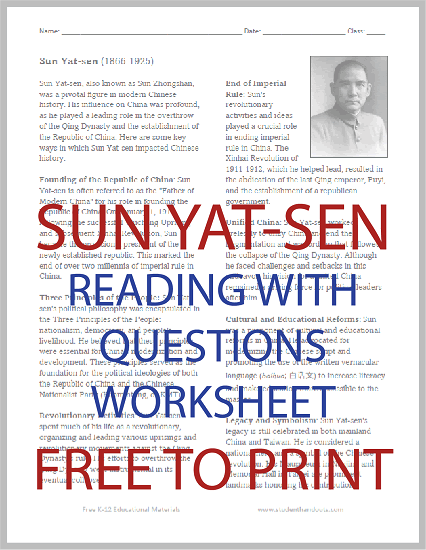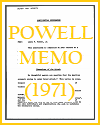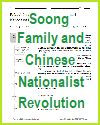| Sun Yat-sen Reading Worksheet |
|---|
| www.studenthandouts.com ↣ World History ↣ Chinese Revolution ↣ Chinese Revolution Worksheets |
 |
 |
|---|
|
This two-sided printable features a brief biography of Sun Yat-sen, followed by questions. Click here to print. The answer key is below. Sun Yat-sen (1866-1925) Sun Yat-sen, also known as Sun Zhongshan, was a pivotal figure in modern Chinese history. His influence on China was profound, as he played a leading role in the overthrow of the Qing Dynasty and the establishment of the Republic of China. Here are some key ways in which Sun Yat-sen impacted Chinese history: Founding of the Republic of China: Sun Yat-sen is often referred to as the "Father of Modern China" for his role in founding the Republic of China. On January 1, 1912, following the successful Wuchang Uprising and subsequent Xinhai Revolution, Sun became the provisional president of the newly established republic. This marked the end of over two millennia of imperial rule in China. Three Principles of the People: Sun Yat-sen's political philosophy was encapsulated in the Three Principles of the People: nationalism, democracy, and people's livelihood. He believed that these principles were essential for China's modernization and development. These principles served as the foundation for the political ideologies of both the Republic of China and the Chinese Nationalist Party (Kuomintang, or KMT). Revolutionary Activities: Sun Yat-sen spent much of his life as a revolutionary, organizing and leading various uprisings and revolutionary movements against the Qing Dynasty's rule. His efforts to overthrow the Qing Dynasty were instrumental in its eventual collapse. End of Imperial Rule: Sun's revolutionary activities and ideas played a crucial role in ending imperial rule in China. The Xinhai Revolution of 1911-1912, which he helped lead, resulted in the abdication of the last Qing emperor, Puyi, and the establishment of a republican government. Unified China: Sun Yat-sen worked tirelessly to unify China and end the fragmentation and warlordism that followed the collapse of the Qing Dynasty. Although he faced challenges and setbacks in this endeavor, his vision for a united China remained a driving force for political leaders after him. Cultural and Educational Reforms: Sun was a proponent of cultural and educational reforms in China. He advocated for modernizing the Chinese script and promoting the use of the written vernacular language (baihua; 白话文) to increase literacy and make education more accessible to the masses. Legacy and Symbolism: Sun Yat-sen's legacy is still celebrated in both mainland China and Taiwan. He is considered a national hero and a symbol of the Chinese revolution. His Mausoleum in Nanjing and Memorial Hall in Taipei are prominent landmarks honoring his contributions. Influence on Chinese Nationalism: Sun Yat-sen's ideas on nationalism and modernization had a lasting impact on Chinese political thought. His vision for a more democratic and progressive China continued to influence political movements in both the Republic of China and the People's Republic of China. Historical Continuity: Sun Yat-sen's transitional government provided a degree of political stability during a critical period in China's history. While he did not live to see all of his ideals fully realized, his efforts set the stage for further political developments in China. Overall, Sun Yat-sen's role in the overthrow of the Qing Dynasty, the establishment of the Republic of China, and the promotion of his Three Principles of the People left an indelible mark on Chinese history. His legacy continues to be celebrated and studied as an integral part of China's modernization and political transformation. |
|
Answer Key 1. When did Sun become the provisional president of the newly established republic? January 1, 1912 2. What were the Three Principles of the People? nationalism, democracy, and people's livelihood 3. Who was the last Qing emperor? Puyi 4. What is baihua? written vernacular Chinese 5. Why do you suppose that Sun Yat-sen is revered in both the Republic of China and the People's Republic of China, despite the vastly different political ideologies of these two entities? Answers will vary. |
| www.studenthandouts.com ↣ World History ↣ Chinese Revolution ↣ Chinese Revolution Worksheets |











